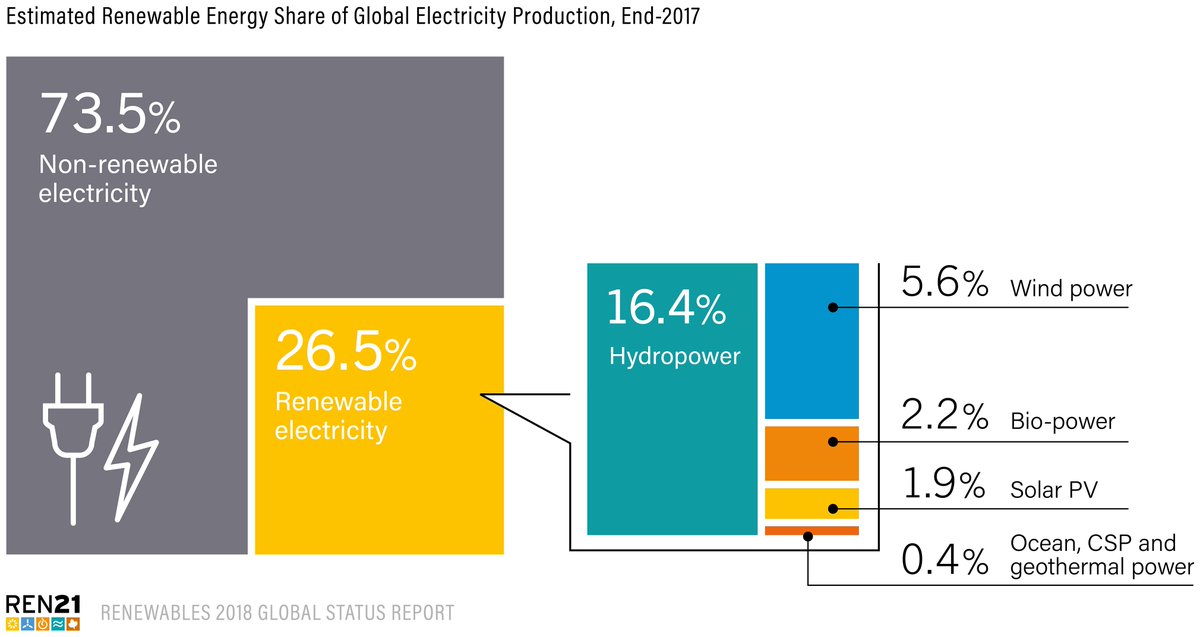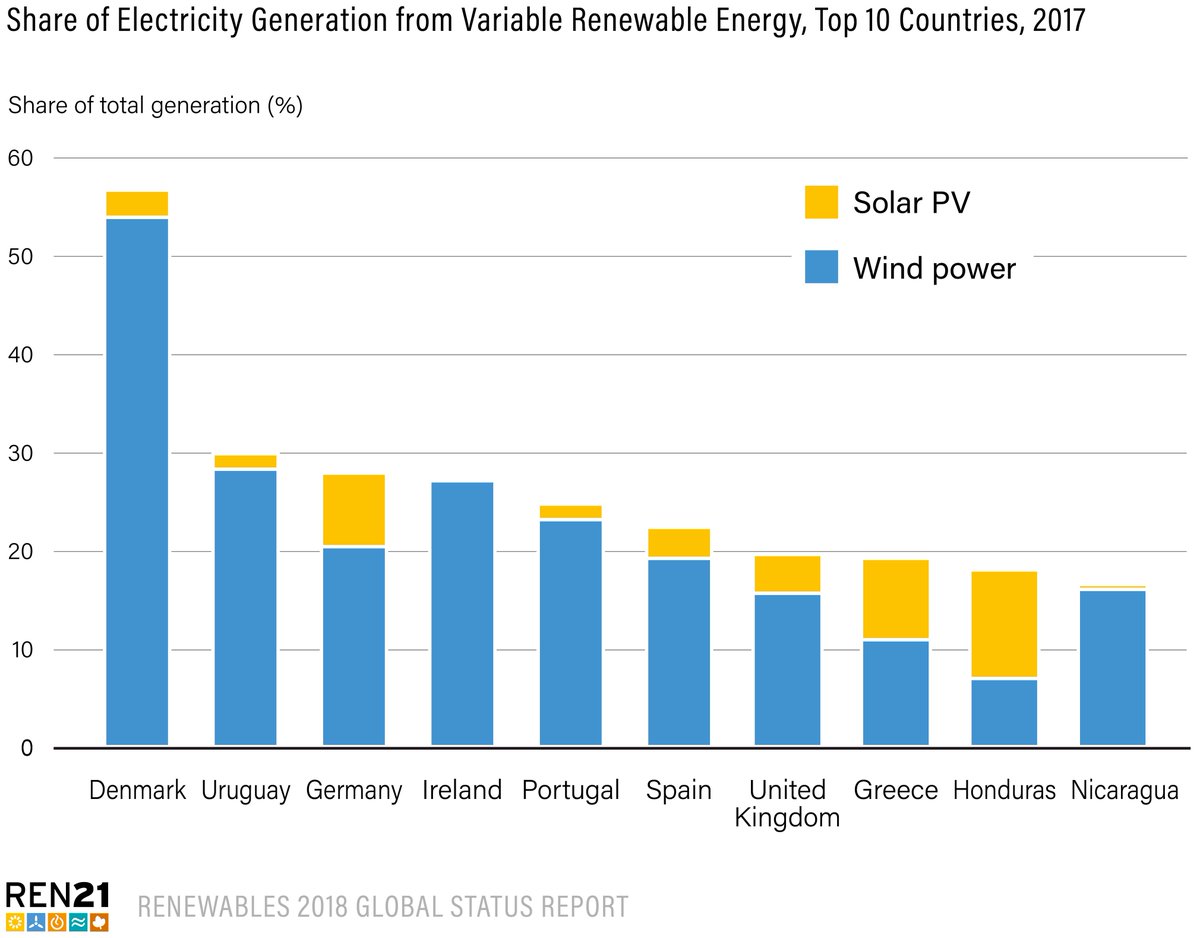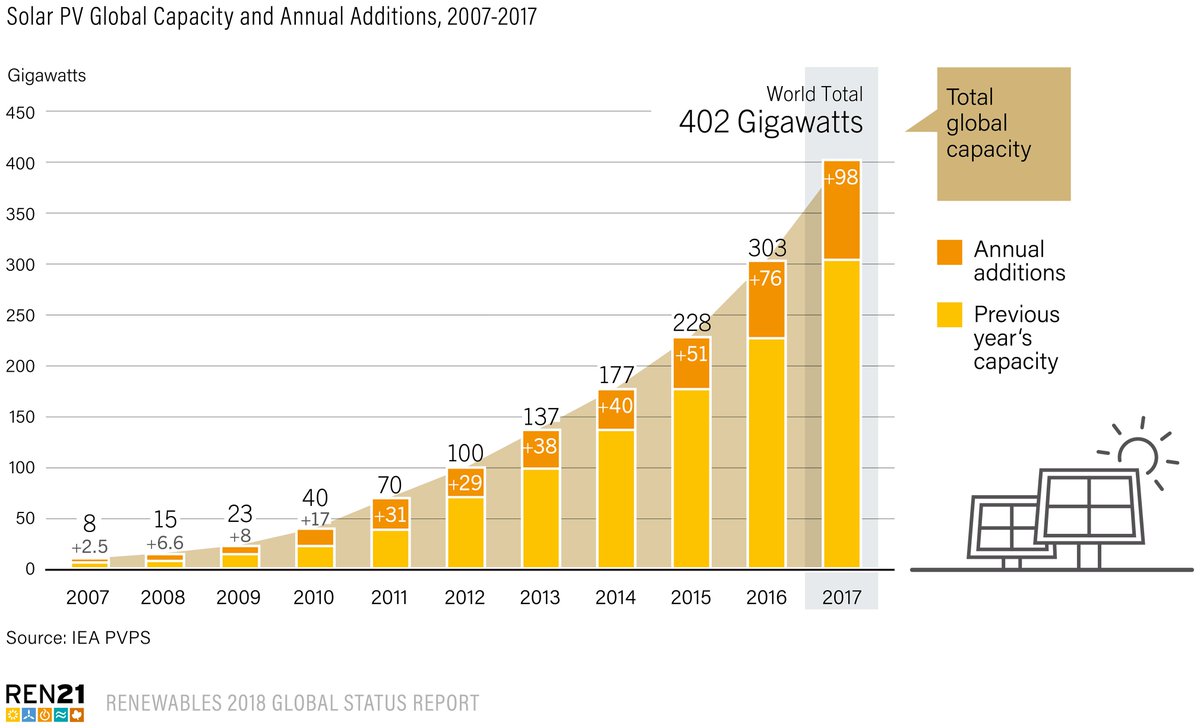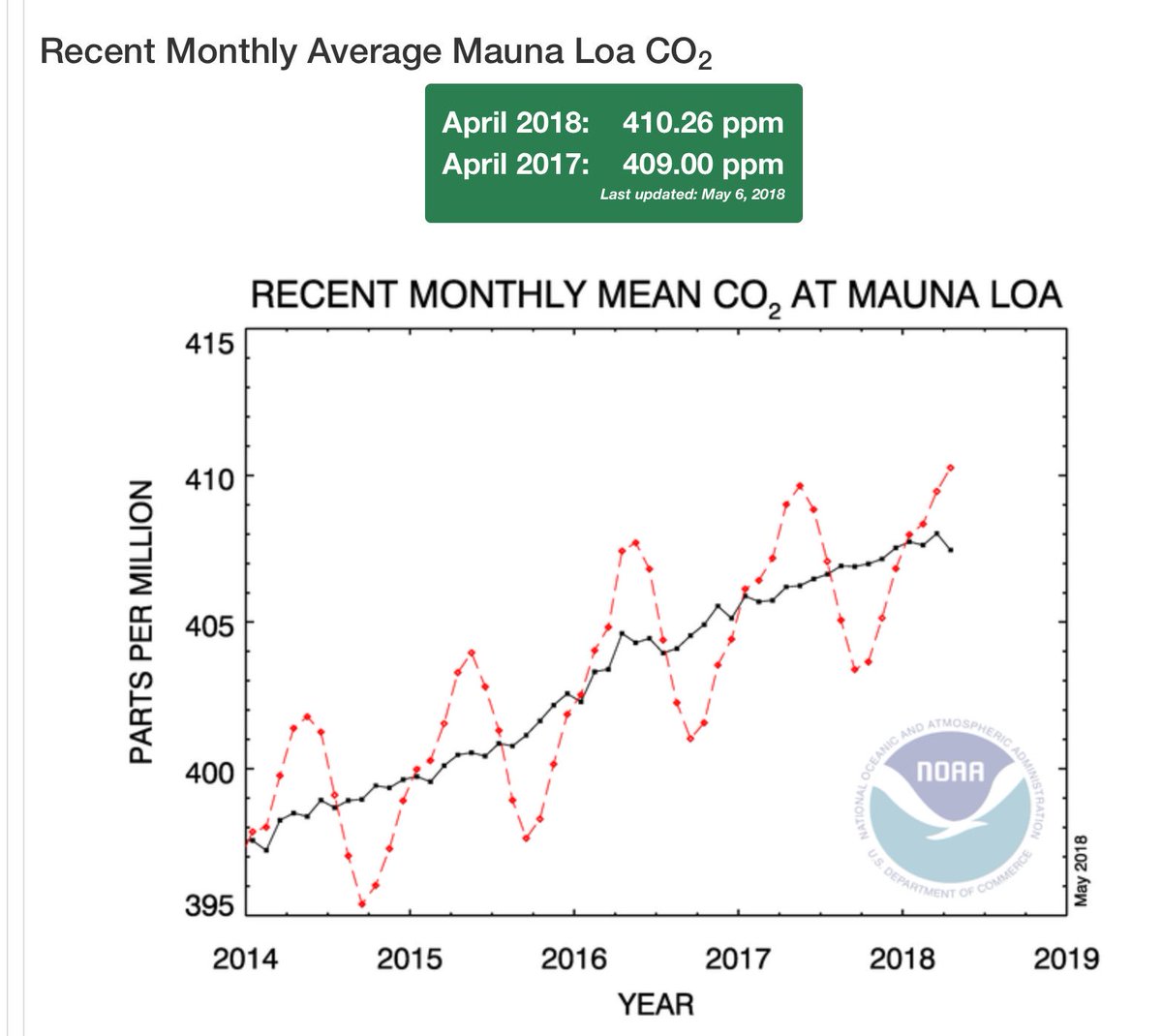In discussions on the climate ‘hothouse’ paper, it’s interesting to see how annoyed some people get by the word stewardship. It’s labeled as anti-conservative, socialist, etc. 

To me, stewardship is a positive word, and I remember it was e.g. often used by christian-democrats in this country. Checking it in the dictionary, I found this. Seems rather appropriate, given the climate crisis we’re causing. 

Maybe the annoyance that "Earth system stewardship" causes has to do with the need for international cooperation it implies, for those who love competition?
Or is it facing planetary boundaries vs "the sky is the limit"?
And here’s the link to that “climate hothouse paper” (open access): pnas.org/content/early/…
Some of those annoyed by the Hothouse Earth paper assume that climate scientists are a monolithic clan, with a unified vision on how the climate crisis should be addressed. They’re not. The paper gives the perspective of a few of them, and others will hold different views.
Given the global nature of the climate crisis (and emissions), it’s clear we’ll need a well co-ordinated global approach to avoid the worst. Our current attempts at working together fall well short of what we need.
My father, a wise man who had experienced the complexity of saving the ozone layer, even thought we’d need a “world government” to address climate change. He was an ingrained christian-democrat, not longing for it, and a scientist, reasoning from the scale of the challenge.
I never understood how such a “world government” could be brought about, or how it would function. But I must agree with him that our efforts so far have been rather ineffective.
Quote from the abstract: We argue that social and technological trends and decisions occurring over the next decade or two could significantly influence the trajectory of the Earth System for tens to hundreds of thousands of years and ...
.. potentially lead to conditions that resemble planetary states that were last seen several millions of years ago, conditions that would be inhospitable to current human societies and to many other contemporary species.
pnas.org/content/early/…
pnas.org/content/early/…
"The rapid trajectory of the climate system over the past half-century along with technological lock in and socioeconomic inertia in human systems commit the climate system to conditions beyond the envelope of past interglacial conditions. "
"We, therefore, suggest that the Earth System may already have passed one “fork in the road” of potential pathways, taking the Earth System out of the next glaciation cycle." (referring to a 2016 paper by Ganopolski e.a.)
"We suggest that biogeophysical feedback processes within the Earth System coupled with direct human degradation of the biosphere may play a more important role than normally assumed, limiting the range of potential future trajectories."
"We argue that there is a significant risk that these internal dynamics, especially strong nonlinearities in feedback processes, could become an important or perhaps, even dominant factor in steering the trajectory that the Earth System actually follows over coming centuries."
The challenge that humanity faces is to create a “Stabilized Earth” pathway that steers the Earth System away from its current trajectory toward the threshold beyond which is Hothouse Earth. 

"Creating such a pathway requires a fundamental change in the role of humans. This stewardship role requires deliberate and sustained action to become an integral, adaptive part of Earth System dynamics, creating feedbacks that keep the system on a Stabilized Earth pathway."
Carbon cycle feedbacks in the Earth System that could accelerate global warming, ranked:
1. Relative weakening of land and ocean physiological carbon sinks
2. Permafrost thawing
3. Amazon forest dieback
4. Boreal forest dieback
5. Increased bacterial respiration in the ocean
1. Relative weakening of land and ocean physiological carbon sinks
2. Permafrost thawing
3. Amazon forest dieback
4. Boreal forest dieback
5. Increased bacterial respiration in the ocean

[Hmm, I see I broke my thread on the "Hothouse Earth" paper here; will do some repair work now]
Most of the feedbacks can show both continuous responses and tipping point behavior in which the feedback process becomes self-perpetuating after a critical threshold is crossed; subsystems exhibiting this behavior are often called “tipping elements” (2008 paper by Lenton e.a.)
A few of the changes associated with the feedbacks are reversible on short timeframes of 50–100 years (e.g., change in Arctic sea ice extent with a warming or cooling of the climate; Antarctic sea ice may be less reversible because of heat accumulation in the Southern Ocean), ..
.. but most changes are largely irreversible on timeframes that matter to contemporary societies (e.g., loss of permafrost carbon).
The so-called “greening” of the planet, caused by enhanced plant growth due to increasing atmospheric CO2 concentration, has increased the land carbon sink in recent decades. However, increasing atmospheric CO2 raises temperature, and hotter leaves photosynthesize less well.
For example, tipping (loss) of the Greenland Ice Sheet could trigger a critical transition in the Atlantic Meridional Ocean Circulation, which could together, by causing sea-level rise and Southern Ocean heat accumulation, accelerate ice loss from the East Antarctic Ice Sheet.
Warming into the range of even the lower-temperature cluster (1-3°C, in which the Paris targets fall) could lead to tipping in the mid- and higher-temperature clusters via cascade effects.
"Based on this analysis of tipping cascades and taking a risk-averse approach, we suggest that a potential planetary threshold could occur at a temperature rise as low as ∼2.0 °C above pre-industrial. "
"Stabilized Earth would require deep cuts in greenhouse gas emissions, protection and enhancement of biosphere carbon sinks, efforts to remove CO2 from the atmosphere, possibly solar radiation management, and adaptation to unavoidable impacts of the warming already occurring."
In essence, the Stabilized Earth pathway could be a regime of the Earth System in which humanity plays an active planetary stewardship role in maintaining a state intermediate between the glacial–interglacial cycle of the past 0.5-1 million years and a Hothouse Earth. 
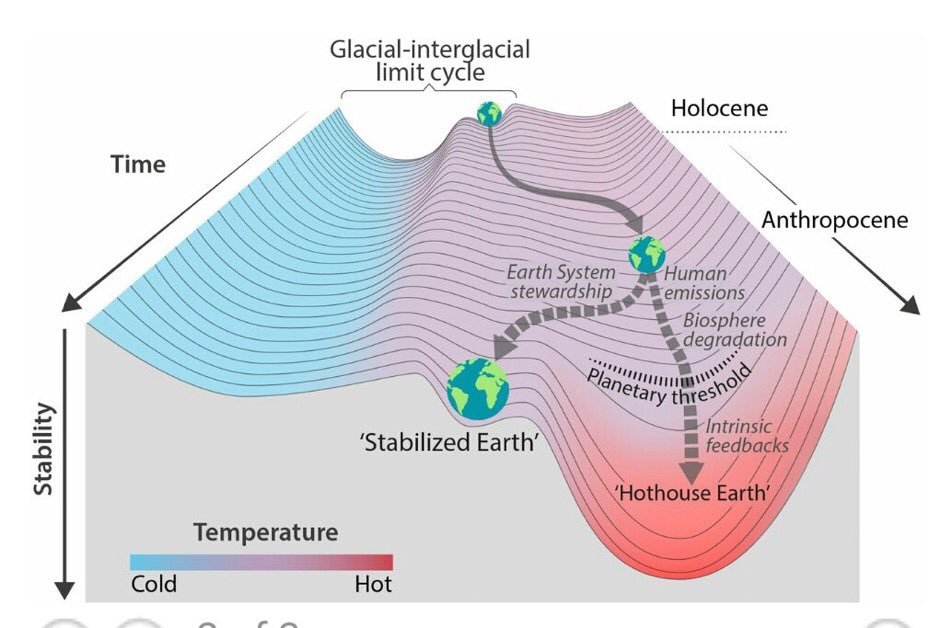
We emphasize that Stabilized Earth is not an intrinsic state of the Earth System but rather, one in which humanity commits to a pathway of ongoing management of its relationship with the rest of the Earth System.
if a planetary threshold is crossed toward the Hothouse Earth pathway, accessing the Stabilized Earth pathway would become very difficult no matter what actions human societies might take.I
Beyond the threshold, positive (reinforcing) feedbacks within the Earth System—outside of human influence or control—could become the dominant driver of the system’s pathway, as individual tipping elements create linked cascades through time and with rising temperature.
Hothouse Earth is likely to be uncontrollable and dangerous to many, particularly if we transition into it in only a century or two, and it poses severe risks for health, economies, political stability, and ultimately, the habitability of the planet for humans.
Agricultural systems are particularly vulnerable, because they are spatially organized around the relatively stable Holocene patterns of terrestrial primary productivity, ...
.. which depend on a well-established and predictable spatial distribution of temperature and precipitation in relation to the location of fertile soils as well as on a particular atmospheric CO2 concentration.
Current understanding suggests that, while a Stabilized Earth pathway could result in an approximate balance between increases and decreases in regional production as human systems adapt, ...
.. a Hothouse Earth trajectory will likely exceed the limits of adaptation and result in a substantial overall decrease in agricultural production, increased prices, and even more disparity between wealthy and poor countries
"Humanity’s challenge then is to influence the dynamical properties of the Earth System in such a way that the emerging unstable conditions in the zone between the Holocene and a very hot state become a de facto stable intermediate state (Stabilized Earth)."
This requires that humans take deliberate, integral, and adaptive steps to reduce dangerous impacts on the Earth System, effectively monitoring and changing behavior to form feedback loops that stabilize this intermediate state.
The required actions fall into three broad categories: (i) reducing greenhouse gas emissions, (ii) enhancing or creating carbon sinks (e.g., protecting and enhancing biosphere carbon sinks and creating new types of sinks) (59), and (iii) modifying Earth’s energy balance ...
.. (for example, via solar radiation management, although that particular feedback entails very large risks of destabilization or degradation of several key processes in the Earth System).
While reducing emissions is a priority, much more could be done to reduce direct human pressures on critical biomes that contribute to the regulation of the state of the Earth System through carbon sinks and moisture feedbacks, such as the Amazon and boreal forests.
International efforts to reduce human impacts on the Earth System while improving wellbeing include the UN Sustainable Development Goals and the commitment in the Paris agreement to keep warming [well] below 2 °C.
As yet, carbon reduction commitments by countries, cities, businesses, and individuals are not enough to meet the Paris target. Enhanced ambition will need new collectively shared values, principles, and frameworks as well as education to support such changes.
In addition to institutional and social innovation at global governance level, changes in demographics, consumption, behavior, attitudes, education, institutions, and socially embedded technologies are all important to maximize the chances of achieving a Stabilized Earth pathway
Ultimately, the transformations necessary to achieve the Stabilized Earth pathway require a fundamental reorientation and restructuring of national and international institutions toward more effective governance at the Earth System level ...
.. with a much stronger emphasis on planetary concerns in economic governance, global trade, investments and finance, and technological development.
Even if a Stabilized Earth pathway is achieved, humanity will face a turbulent road of rapid, profound changes and uncertainties—politically, socially, environmentally—challenging the resilience of societies. Earth will likely be warmer than any time over the last 800,000 years.
The present way of guiding development based on theories, tools, and beliefs of gradual or incremental change, with a focus on economy efficiency, will likely not be adequate to cope with this trajectory. Thus, next to adaptation, increasing resilience will become a key strategy.
Generic resilience-building strategies include developing insurance, buffers, redundancy, diversity, and other features of resilience that are critical for transforming human systems in the face of warming and possible surprise associated with tipping points.
How credible is this analysis? There is significant evidence from a number of sources that the risk of a planetary threshold and thus, the need to create a divergent pathway should be taken seriously:
1. Good understanding of the complex system behavior of the Earth System in the past 0.5-1 million years.
2. Insights from Earth’s recent geological past in conditions that can be reached with CO2 and temperature levels realized or projected for this century.
2. Insights from Earth’s recent geological past in conditions that can be reached with CO2 and temperature levels realized or projected for this century.
3. Knowledge of a number of important tipping elements and feedback processes.
4. Contemporary observations of tipping element behavior at an observed temperature anomaly of about 1 °C above preindustrial.
4. Contemporary observations of tipping element behavior at an observed temperature anomaly of about 1 °C above preindustrial.
Our initial analysis here needs to be underpinned by more in-depth, quantitative Earth System analysis and modeling studies to address 3 critical questions. (i) Is humanity at risk for pushing the system across a planetary threshold and irreversibly down a Hothouse Earth pathway?
(ii) What other pathways might be possible in the complex stability landscape of the Earth System, and what risks might they entail?
(iii) What planetary stewardship strategies are required to maintain the Earth System in a manageable Stabilized Earth state?
(iii) What planetary stewardship strategies are required to maintain the Earth System in a manageable Stabilized Earth state?
That was the short version; I hope it was helpful.
For (much) more: read the full #HothouseEarth paper, and its Supplementary Information, for yourself here: pnas.org/content/early/… (open access!)
For (much) more: read the full #HothouseEarth paper, and its Supplementary Information, for yourself here: pnas.org/content/early/… (open access!)
Epilogue: This #HothouseEarth paper builds a strong case for aiming to keep global warming to 1.5°C. The chances to avoid slipping away to a 'hothouse' state will be much better than if we hit 2°C.
Our view on what that would mean for the energy system: ecofys.com/en/publication…
Our view on what that would mean for the energy system: ecofys.com/en/publication…
• • •
Missing some Tweet in this thread? You can try to
force a refresh




